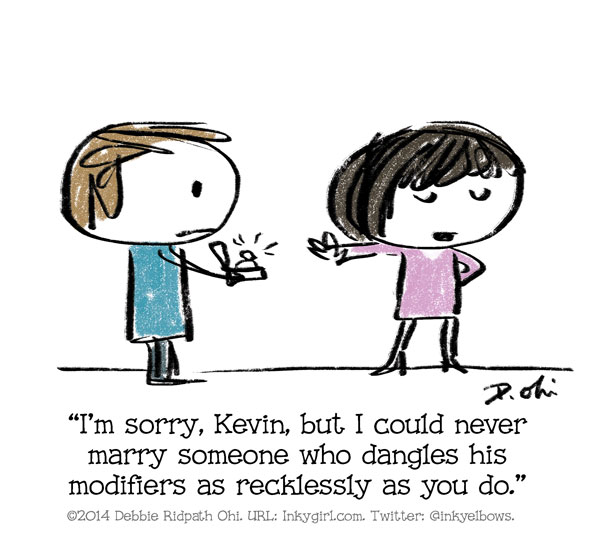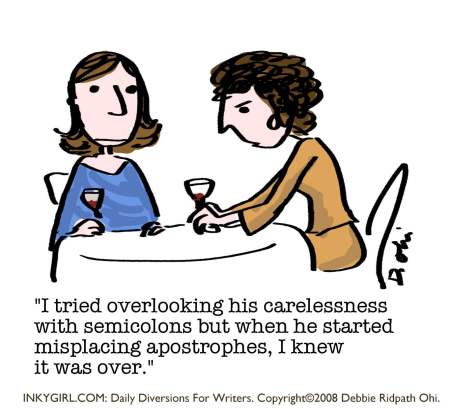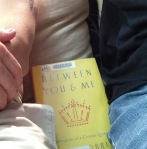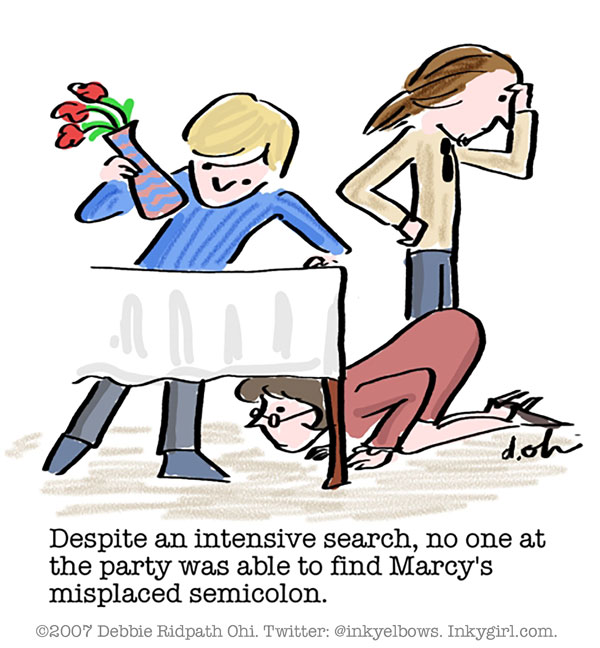Check out these quick, easy grammar lessons that will clean up and power up your students' writing. ![]()
Viewing: Blog Posts Tagged with: grammar, Most Recent at Top [Help]
Results 1 - 25 of 209
Blog: TWO WRITING TEACHERS (Login to Add to MyJacketFlap)
JacketFlap tags: conventions, editing, grammar, dialogue, punctuation, paragraphing, Add a tag
Blog: OUPblog (Login to Add to MyJacketFlap)
JacketFlap tags: Books, grammar, Philosophy, linguistics, english language, *Featured, paradoxes, yablo paradox, Arts & Humanities, Roy T. Cook, Paradoxes and Puzzles with Roy T. Cook, paradoxes and puzzles with Roy T Cook, periphrastic, Add a tag
Let us say that a sentence is periphrastic if and only if there is a single word in that sentence such that we can remove the word and the result (i) is grammatical, and (ii) has the same truth value as the original sentence.
The post Periphrastic puzzles appeared first on OUPblog.
Blog: Just the Facts, Ma'am (Login to Add to MyJacketFlap)
JacketFlap tags: grammar, Add a tag
This handy checklist will help you eliminate grammatical mistakes in your manuscript.
http://www.quickanddirtytips.com/education/grammar/grammar-girls-editing-checklist
Blog: OUPblog (Login to Add to MyJacketFlap)
JacketFlap tags: Holy Cross Day, Newgate Street, Nutting Day, Books, grammar, Language, folklore, Oxford Etymologist, word origins, english, anatoly liberman, Linguistics, english language, *Featured, Anglo-Saxon word etymology, Anatoly Liberman Column, Add a tag
All words, especially kl-words, and no play will make anyone dull. The origin of popular sayings is an amusing area of linguistics, but, unlike the origin of words, it presupposes no technical knowledge. No grammar, no phonetics, no nothin’: just sit back and relax, as they say to those who fly overseas first class. So here is another timeout.
The post As black as what? appeared first on OUPblog.
Blog: Just the Facts, Ma'am (Login to Add to MyJacketFlap)
JacketFlap tags: grammar, voice, Add a tag
Sometimes you have to break grammatical rules to bring out your voice.
http://mythicscribes.com/writing-techniques/voice-vs-grammar/
Blog: TWO WRITING TEACHERS (Login to Add to MyJacketFlap)
JacketFlap tags: conventions, grammar, writing workshop, Add a tag
How do you find time to put a focus on the littlest pieces of our writing to create big pieces of work?![]()
Blog: Inkygirl: Daily Diversions For Writers (Login to Add to MyJacketFlap)
JacketFlap tags: grammar, rejection, Comics for writers, proposal, Add a tag
Blog: OUPblog (Login to Add to MyJacketFlap)
JacketFlap tags: Books, names, History, grammar, Language, communication, etymology, Linguistics, naming, place names, *Featured, Place Name Etymology, Carole Hough, name meaning, name studies, name theory, names in literature, onomastics, proper nouns, socio-onomastics, The Oxford Handbook of Names and Naming, Add a tag
Name studies have been around for a long time. In Ancient Greece, philosophers like Socrates, Plato, and Aristotle saw names as central to the understanding of language, providing key insights into human communication and thought. Still, to the present day, questions such as Are names nouns? and Do names have meaning? are still hotly debated by scholars within both linguistics and name studies.
The post Is name studies a discipline in its own right? appeared first on OUPblog.
Blog: OUPblog (Login to Add to MyJacketFlap)
JacketFlap tags: Arts & Humanities, simon horobin, How English Became English, american education system, Gwynne’s Grammar, latin nouns, teaching latin, Books, Literature, Education, grammar, Language, etymology, Linguistics, Latin, english language, teaching english, webster, *Featured, Add a tag
English grammar has been closely bound up with that of Latin since the 16th century, when English first began to be taught in schools. Given that grammatical instruction prior to this had focused on Latin, it’s not surprising that teachers based their grammars of English on Latin. The title of John Hewes’ work of 1624 neatly encapsulates its desire to make English grammar conform to that of Latin.
The post How English became English – and not Latin appeared first on OUPblog.
Blog: Inkygirl: Daily Diversions For Writers (Login to Add to MyJacketFlap)
JacketFlap tags: books, grammar, Comics for writers, bibliophile, Add a tag

Blog: Inkygirl: Daily Diversions For Writers (Login to Add to MyJacketFlap)
JacketFlap tags: grammar, punctuation, Comics for writers, breakup, Add a tag
Blog: OUPblog (Login to Add to MyJacketFlap)
JacketFlap tags: generic "he", Readers Writers and the Digital Revolution, Books, History, Law, Politics, gender, grammar, Language, feminism, sexism, America, he, Linguistics, women's suffrage, pronouns, A Better Pencil, *Featured, Add a tag
There’s been a lot of talk lately about what pronouns to use for persons whose gender is unknown, complicated, or irrelevant. Options include singular they and invented, common-gender pronouns. Each has its defenders and its critics.
The post Gender politics of the generic “he” appeared first on OUPblog.
Blog: The Bookshelf Muse (Login to Add to MyJacketFlap)
JacketFlap tags: Grammar, Guest Editor, Guest Post, Editing Tips, Revision and Editing, Uncategorized, Add a tag
 Hi everyone–I hope you had a terrific weekend and are in the mood to learn. Today I’m handing over the blog keys to Rachel Starr Thomson, one of editors who have jointly written 5 Editors Tackle the 12 Fatal Flaws of Fiction Writing. I’m excited about this venture of Rachel’s as the book features more than sixty detailed Before and After examples of flawed and corrected passages to help authors learn to spot flaws in their writing. Seeing real examples is a great way to elevate your writing.
Hi everyone–I hope you had a terrific weekend and are in the mood to learn. Today I’m handing over the blog keys to Rachel Starr Thomson, one of editors who have jointly written 5 Editors Tackle the 12 Fatal Flaws of Fiction Writing. I’m excited about this venture of Rachel’s as the book features more than sixty detailed Before and After examples of flawed and corrected passages to help authors learn to spot flaws in their writing. Seeing real examples is a great way to elevate your writing.
The Fatal Flaw of Underwriting
Fundamentally, when we write a story, we want to connect with readers’ emotions. Engage emotion. Elicit it. Give readers a story they don’t just learn but one they feel and will never forget.
Yet emotion is one of the story elements most commonly underwritten—and underwriting in general tends to harm emotional connection the most.
Underwriting is just what it sounds like: it’s the failure to put things on the page that need to be there. When somebody picks up a gun and fires it off, and we didn’t know there was a gun on stage, that’s underwriting. When someone makes a decision completely out of the blue, leaving us not so much surprised as confused, that’s underwriting. When a story just plain doesn’t make sense, it’s probably underwritten.
And when no matter how hard you try, you just can’t give a damn about the characters? Most likely underwriting is at fault.
Why We Underwrite
The dirty little secret, though? Underwriting is sometimes (often) a direct result of following editorial advice like “show, don’t tell,” and “make sure your scenes are active and full of conflict” and “don’t info dump or fill your scenes with backstory.”
As an editor who also writes stuff (a lot of stuff), allow me to eat humble pie and tell you that sometimes we push you to strip so much out of your story that it ends up gasping for breath, struggling to hang on to a shred of character or conflict that anyone cares about.
I’ve been there. I once misinterpreted “show don’t tell” so horrendously that I thought it meant everything had to be conveyed through action and dialogue alone, and I was never allowed to include thoughts or backstory. Talk about gutting a book!
Connecting
Underwriting hurts emotional connection so badly because it turns everything 2D. We lose contact with really essential parts of our stories, settings, and characters when we fail to include what needs to be there.
In particular, these three often-underwritten areas can make or break connection:
Process. When your character goes from decision point A (“I will not go to the ball”) to decision point B (“I will go to the ball”), and we didn’t see any of the decision process, it’s impossible to feel invested in the question. The Rule of Three is helpful here: in a decision of midlevel importance (meaning it’s more important than “I think I’ll brush my teeth” and less important than “I think I’ll marry the hero after all”), show three stages of the decision-making progress.
I will not go to the ball.
- But then I just learned my best friend is going.
- If my best friend goes, she will exceed my popularity.
- If she exceeds my popularity, I will lose the interest of the prince.
I will go to the ball after all.
Reaction. In my clients’ manuscripts, it’s amazing how often something will happen that ought to get a reaction from the POV character … and it doesn’t. I mean, somebody’s mother might have just died, and we get crickets. When you’re in POV you always always always have to react. Even if you don’t react, it has to be because you’re being so darn deliberate about not reacting. If the temperature drops, shiver. If someone dies, cry. If someone says something provocative, have an opinion about it.
Many times, I’ve had a client return a manuscript after revision, and simply by adding reaction—usually in the form of a thought, shown through deep POV—they had absolutely transformed the story. A character who responds to things is alive, and through that character, the story can be experienced at far greater depth.
The Thoughts Behind Emotion. This is a biggie, and it’s where “show don’t tell” can be so incredibly damaging when misunderstood. We know not to write “She was angry.” So instead, many writers revert to writing “body emotions”: “She ground her teeth.” “She turned red.” This makes for a lot of odd and sometimes unclear images, but it doesn’t connect us to the character’s emotion at all. We see her feeling something; we don’t feel it. The best way to convey emotion, it turns out, is to write thoughts. We feel in response to things we’re thinking. So do our characters. If you can show what they are thinking, nine times out of ten you can make an emotional connection with your readers.
Words are the stuff of our worlds. Without words to translate into vivid images, actions, thought processes, emotions, settings, and more, none of those things can exist. So underwriting is actually as great a danger to a novelist as overwriting—perhaps even a greater one.
Thankfully, underwriting not irreparable. In fact, when we go and fill in the gaps, we might just discover the missing heart of our own stories.
 Rachel Starr Thomson is the author of eighteen novels. As an editor and writing coach, she has helped writers achieve their best work for over a decade—so she’s thrilled to contribute to The Writer’s Toolbox series, which gives fiction writers everything they need to know to create compelling, solid stories, with 5 Editors Tackle the 12 Fatal Flaws of Fiction Writing.
Rachel Starr Thomson is the author of eighteen novels. As an editor and writing coach, she has helped writers achieve their best work for over a decade—so she’s thrilled to contribute to The Writer’s Toolbox series, which gives fiction writers everything they need to know to create compelling, solid stories, with 5 Editors Tackle the 12 Fatal Flaws of Fiction Writing.
You can check out all Rachel’s books at her website.
Which of these three areas of underwriting do you struggle with? Let us know in the comments!
The post The Fatal Flaw of Underwriting appeared first on WRITERS HELPING WRITERS™.
Blog: Read Roger - The Horn Book editor's rants and raves (Login to Add to MyJacketFlap)
JacketFlap tags: Lolly's Classroom, School, writing, grammar, punctuation, teaching writing, fluency, k-12, Add a tag
At a recent training on fluency, I found myself discussing strategies about how to help the “racing reader” — the reader who, when asked to read aloud, whips through the text on a page as fast as possible. One of the key strategies that I discussed with the tutors that I coach was building awareness of the purpose of punctuation with all young readers. This suggestion sparked a conversation about how punctuation, and grammar more broadly, gets taught in schools.
Far too often, punctuation instruction is delivered through grammar worksheets or exercises that ask students to choose the correct ending punctuation for a sentence, to put commas in appropriate places, or to correct incorrect punctuation usage in a given passage. When discussing punctuation in the context of fluency, we often teach readers to raise their voices when they encounter a question mark, but less frequently discuss why the author chose to use a question mark there in the first place. Rarely are students clued into the real reason they should give a hoot about punctuation: those symbols on the page are a road map given by a writer to help a reader understand how to read their words.
Luckily, a number of books exist that can be used with writers of all ages to highlight the essential role that punctuation plays in written communication and to foster this deeper understanding of punctuation.
 Eats, Shoots, and Leaves by Lynne Truss
Eats, Shoots, and Leaves by Lynne Truss
This highly entertaining book shows how miscommunication can abound when commas don’t send the right signals to readers. As she writes in the introduction: “You might want to eat a huge hot dog, but a huge, hot dog would run away pretty quickly if you tried to take a bite out of him.” Truss also has two other titles The Girl’s Like Spaghetti (apostrophes) and Twenty-Odd Ducks (mixed punctuation) that employ the same humorous approach to punctuation.
 Punctuation Takes a Vacation by Robin Pulver, illustrated by Lynn Rowe Reed
Punctuation Takes a Vacation by Robin Pulver, illustrated by Lynn Rowe Reed
What will happen when punctuation decides to take a break? As the punctuation marks go on strike because they feel underappreciated, Pulver’s book illustrates the challenges in communicating clearly when punctuation isn’t an option. The book lends itself to a number of follow-up activities where students could attempt to communicate a message without the use of punctuation.
 Yo! Yes? by Chris Raschka
Yo! Yes? by Chris Raschka
While not specifically focused on punctuation, Yo! Yes? explores the ways in which meaning can be conveyed or altered through the inflections in our voices that punctuation signals us to make and could serve as a great jumping off point for discussions about why authors choose a specific punctuation symbol at a certain time.
By using children’s literature as an entry point into grammar lessons, students can develop a richer understanding of the why behind punctuation, an understanding they can then use to hone their own skills as writers and fluent readers.
The post Punctuation: the junction between reading and writing appeared first on The Horn Book.
Blog: OUPblog (Login to Add to MyJacketFlap)
JacketFlap tags: grammar, Language, evolution, bonobo, Anthropology, OSO, linguistics, UPSO, *Featured, human evolution, university press scholarship online, syntax, Online products, Oxford Scholarship Online, language evolution, foundations of language, global languages, grammar evolution, kanzi, Ljiljana Progovac, the expression of the emotions in man and animals, verb-non compounds, Add a tag
In order to hypothesize about the evolutionary origins of grammar, it is essential to rely on some theory or model of human grammars. Interestingly, scholars engaged in the theoretical study of grammar (syntacticians), particularly those working within the influential framework associated with linguist Noam Chomsky, have been reluctant to consider a gradualist, selection-based approach to grammar.
The post Did human grammar(s) evolve? appeared first on OUPblog.
Blog: Galley Cat (Mediabistro) (Login to Add to MyJacketFlap)
JacketFlap tags: grammar, Resources, infographic, Add a tag
Blog: So Many Books (Login to Add to MyJacketFlap)
JacketFlap tags: Books, Reviews, Writing, Grammar, Mary Norris, Add a tag
I believe it was Joan who prompted me to get myself in the library hold queue for Between You and Me by Mary Norris and I am glad I did! Norris has spent over thirty years as a copy editor for The New Yorker. She has stories! She also knows her grammar. Although she frequently recognizes that New Yorker style and the grammar everyone else uses don’t always align. And yes, she reports people being afraid her at parties, worried they are going to say something incorrect and that she will judge them. Norris insists she has no time or inclination for that malarky yet however reassuring she tries to be, there are some who can’t believe she isn’t silently ripping them to shreds.
A pity too because if she is anything in person like she is in her book, she has a great sense of humor. Though as a grammar geek she does have issues as anyone who is geeky about something will. Like the time she read Light Years by James Salter. She had been hearing about how good he is for a long time and finally decided to read one of his books. She loved it but was pulled up by one sentence, particularly a comma in that one sentence, that seemed to her unnecessary. It bugged her so much she wrote him a letter asking about it. Salter kindly wrote back to her and explained why he used a comma where he did and Norris was completely satisfied with his answer. How many of us would write an author about a comma?
The book is part memoir, part grammar lesson, and sprinkled with the occasional hint of annoyance over all the mistakes people make on a daily basis. There is an entire chapter on “you and I” versus “you and me” and why most of the time “you and me” is the correct usage. Another chapter discusses the problem of there being no gender non-specific pronoun in English that accounts for he and she, him and her, forcing people into terrible grammar contortions and even prompting many to suggest such near atrocities as “ne, nis, nim” or “shi, shis, shim” or “mef” or “hu.” She acknowledges most people have thrown in the towel and settled for “they” and “their” and while she can manage to not be too upset by “they,” “their” is completely unacceptable in her book.
Other things we learn are the correct usage of “which” and “that.” While I was reading it I felt I would never forget the rules but if you ask me right now I will mumble something about restrictive and nonrestrictive clauses and oh, I’m sorry, I have to go take this phone call. I know I get these mixed up all the time but it is hard to make myself care. Should I?
One of my favorite chapters is on dashes, semicolons, and colons. I love dashes and once, long ago, after reading all of Emily Dickinson’s poems over the course of a month, I became a dash maniac. I have since tempered my usage but —oh! — I love them so. I used to be terrified of semicolons and would do my best to avoid any sentence that might need one. But a few years ago I read something, I can’t remember what, that gave me the confidence to start using them. And once I began I decided I really like semicolons even if I am never actually certain whether I am using them correctly. In her chapter Norris does a marvelous analysis on how Henry James uses semicolons. You will not be surprised to know he is absolutely brilliant at it. I am shy about colons and will probably always remain so. I had a writing teacher once drill into my head that a colon was like a big neon sign and that if I ever used one, what came after it had better be good. I guess you could say my shyness of colons stems from a fear that I could never say anything good enough to justify a neon sign. Norris is more reassuring on the matter but I believe I have been scarred for life.
At times I felt like Norris comes across a teeny bit condescending and know-it-all. Perhaps given her position at the New Yorker she really does know it all, but no one likes that especially when it comes to grammar. She has a light, breezy style and is witty and funny, but sometimes her jokes fell flat with me, particularly in her chapter about profanity. However, Between You and Me is overall a fun and enjoyable book that includes some of the most pleasant grammar lessons I have ever had. I highly recommend it should you ever need something to fill an empty spot in your TBR pile.
Filed under: Books, Reviews, Writing Tagged: Grammar, Mary Norris
Blog: Galley Cat (Mediabistro) (Login to Add to MyJacketFlap)
JacketFlap tags: Videos, grammar, Resources, TED Talks, Add a tag
Blog: Just the Facts, Ma'am (Login to Add to MyJacketFlap)
JacketFlap tags: grammar, Add a tag
Make sure you avoid these mistakes many people make.
https://litreactor.com/columns/20-common-grammar-mistakes-that-almost-everyone-gets-wrong
Blog: OUPblog (Login to Add to MyJacketFlap)
JacketFlap tags: Books, god, grammar, gothic, Language, Oxford Etymologist, word origins, etymology, anatoly liberman, phonetics, *Featured, Dictionaries & Lexicography, etymology of god, Bishop Wulfila, pagan gods, Add a tag
From what was said last week it follows that pagans did not need a highly charged word for “god,” let alone “God.” They recognized a hierarchy of supernatural beings and the division of labor in that “heavenly” crowd. Some disturbed our dreams, some bereaved us of reason, and still others inflicted diseases and in general worked evil and mischief.
The post Playing God, Chapter 2 appeared first on OUPblog.
Blog: Galley Cat (Mediabistro) (Login to Add to MyJacketFlap)
JacketFlap tags: Videos, grammar, Resources, TED Talks, Add a tag
Blog: Galley Cat (Mediabistro) (Login to Add to MyJacketFlap)
JacketFlap tags: Videos, grammar, Trends, parody, Add a tag
Blog: Seize the Day (Login to Add to MyJacketFlap)
JacketFlap tags: grammar, Language, Revision, Add a tag
Hi folks, I am writing a summer long series. It's called Publish and is in conjunction with my TEENSPublish workshop at the Ringer Library in College Station, Texas. The tribe is working hard. The title of our anthology is A New Generation: TEENSPublish 2015 Anthology. We have moved into the last phase of our project: revision.
Revision is hard work. It's tedious at times. It's not fast. It does lead to what you meant to say. And that is everything,isn't it.
I will be back next week with more revision stuff. The last in this series!
Here is a doodle. My son Jesse at age 3.
A quote for your pocket:
Writing is an act of faith, not a trick of grammar. E.B. White
Blog: Inkygirl: Daily Diversions For Writers (Login to Add to MyJacketFlap)
JacketFlap tags: grammar, punctuation, semicolon, search, Comics for writers, Add a tag
Blog: Galley Cat (Mediabistro) (Login to Add to MyJacketFlap)
JacketFlap tags: Videos, grammar, Resources, TED Talks, Add a tag
Have you ever feared the semicolon? Get ready to tackle this fear with a grammar lesson from the TED-Ed team.
The animated video embedded above features a three-minute lesson to discuss the semicolon and demonstrate its proper usage. Over at the TED-Ed website, viewers can access a quiz, a discussion board, and more resources.
Click here to check out a comic by The Oatmeal for more information about the semi colon. What’s your favorite punctuation mark?
Add a CommentView Next 25 Posts







